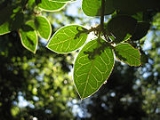
Citronella mucronata
Encyclopedia
Citronella mucronata, the Huillipatagua (wiʎipaˈtaɣwa) or Chilean citronella tree, is an evergreen tree native to Chile
, it occurs from 30 to 41° south latitude. Growing up to 1400 m (4600 ft) a.s.l. It is frequently found on moist sites.
in the axils of the side veins, and the veins are yellow, the leaves are glossy green above, and paler bellow. Small petioles
. The flowers are hermaphrodite
and whitish yellow and arranged in terminal panicle
s 4–8 cm long. The calyx is made up by 5 sepal
s, the corolla has 5 free petal
s. The fruit is a spherical drupe
about 1-1.2 cm in diameter which is purple when mature.
.
Chile
Chile ,officially the Republic of Chile , is a country in South America occupying a long, narrow coastal strip between the Andes mountains to the east and the Pacific Ocean to the west. It borders Peru to the north, Bolivia to the northeast, Argentina to the east, and the Drake Passage in the far...
, it occurs from 30 to 41° south latitude. Growing up to 1400 m (4600 ft) a.s.l. It is frequently found on moist sites.
Description
It reaches up to 10 m (30 ft) and 1 m (3 ft) in diameter. The bark is dark gray and rough. The leaves are alternate, leathery, the edge is entire or toothed, ovate or oblong with an acute apex (tip) which ends in a mucro (sharp point). The leaves are about 4,5-6 long and 2,5–4 cm and wide, with domatiaDomatia
Domatia are tiny chambers produced by plants that house arthropods.Domatia differ from galls in that they are produced by the plant rather than being induced by their inhabitants...
in the axils of the side veins, and the veins are yellow, the leaves are glossy green above, and paler bellow. Small petioles
Petiole (botany)
In botany, the petiole is the stalk attaching the leaf blade to the stem. The petiole usually has the same internal structure as the stem. Outgrowths appearing on each side of the petiole are called stipules. Leaves lacking a petiole are called sessile, or clasping when they partly surround the...
. The flowers are hermaphrodite
Hermaphrodite
In biology, a hermaphrodite is an organism that has reproductive organs normally associated with both male and female sexes.Many taxonomic groups of animals do not have separate sexes. In these groups, hermaphroditism is a normal condition, enabling a form of sexual reproduction in which both...
and whitish yellow and arranged in terminal panicle
Panicle
A panicle is a compound raceme, a loose, much-branched indeterminate inflorescence with pedicellate flowers attached along the secondary branches; in other words, a branched cluster of flowers in which the branches are racemes....
s 4–8 cm long. The calyx is made up by 5 sepal
Sepal
A sepal is a part of the flower of angiosperms . Collectively the sepals form the calyx, which is the outermost whorl of parts that form a flower. Usually green, sepals have the typical function of protecting the petals when the flower is in bud...
s, the corolla has 5 free petal
Petal
Petals are modified leaves that surround the reproductive parts of flowers. They often are brightly colored or unusually shaped to attract pollinators. Together, all of the petals of a flower are called a corolla. Petals are usually accompanied by another set of special leaves called sepals lying...
s. The fruit is a spherical drupe
Drupe
In botany, a drupe is a fruit in which an outer fleshy part surrounds a shell of hardened endocarp with a seed inside. These fruits develop from a single carpel, and mostly from flowers with superior ovaries...
about 1-1.2 cm in diameter which is purple when mature.
Cultivation and uses
It is a beautiful tree and very ornamental and tolerates frosts in winters. It has been planted in SpainSpain
Spain , officially the Kingdom of Spain languages]] under the European Charter for Regional or Minority Languages. In each of these, Spain's official name is as follows:;;;;;;), is a country and member state of the European Union located in southwestern Europe on the Iberian Peninsula...
.

